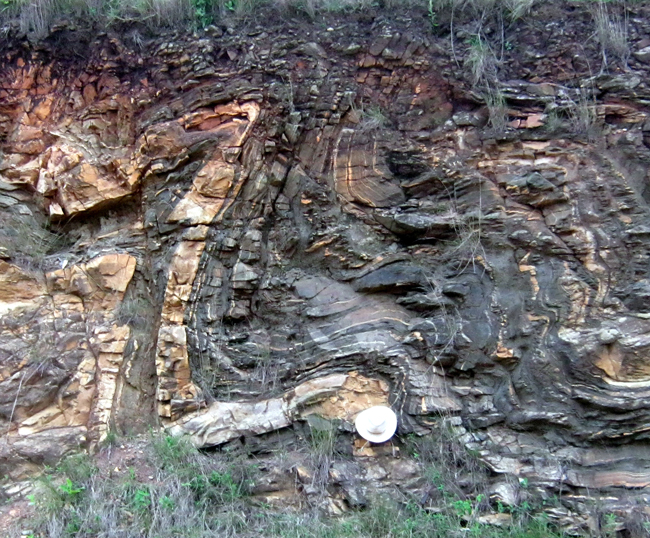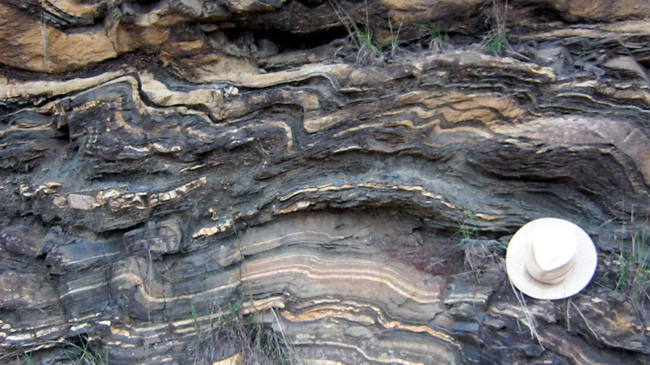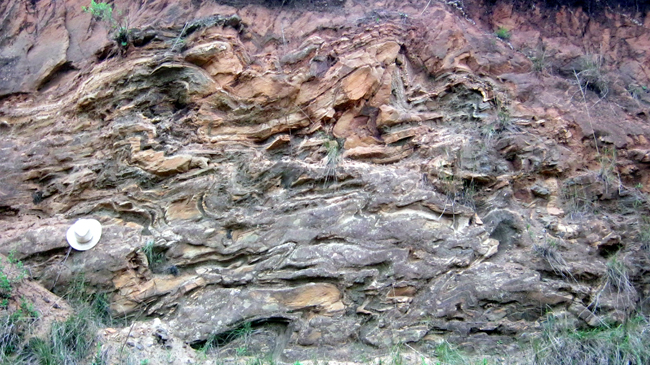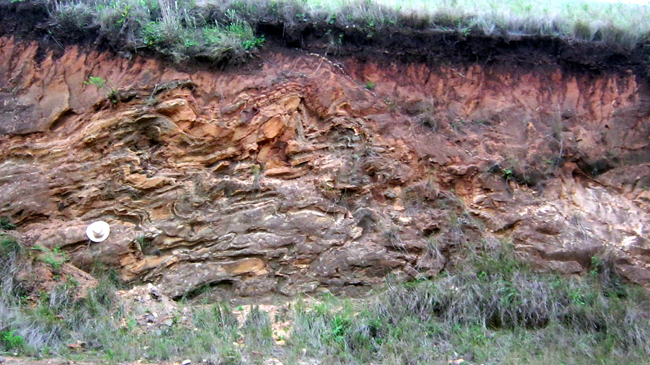Martin Bentley* submitted this week’s Friday fold(s):
This outcrop appears on a:
road cutting between the towns of Eshowe and Nkandla, in KwaZulu-Natal, South Africa. Some very nice folds are exposed, in particular some small-scale parasitic folds in places.
This part of the country falls into the Natal Metamorphic Suite, in particular the Khomo Formation of the Nkomo Nappe.
My resources are unfortunately limited, but I believe that this is a foliated melanocratic amphibolite formation.
Site coördinates are 28°50’27.03″S; 31°11’12.58″E, but nothing is visible in Google Earth. The outcrops in this part of the world are generally pretty bad (lots of rolling hills covered in vegetation), but similarly aged rocks are found in the Northern Cape, and are much better exposed there. They together form the Namaqua-Natal Metamorphic Suite, and are dated to around 1.2Ga.
Some more… Martin’s wide-brimmed sun hat appears as a sense of scale.






Thanks, Martin! Happy Friday!
___________________
* We’re not sure if we’re related or not. We have genealogists looking into it.

 Click to enlarge
Click to enlarge
Hi, I’m a geophysics undergraduate and a big fan of your blog! Long time lurker, first time poster, I’ve got a structural geology fieldtrip coming up and just wondered whether or not you are able to give any advice on annotating field photos. Take the most recent Friday fold as an example: I have attempted to annotate it as best I can (link below), but really have no idea how I would annotate areas A and B, and also I don’t know if I’ve missed any key structural features (yellow = attempting to follow bedding planes (?), red = mineral vein, and also I appreciate that there are parasitic folds at various points on the outcrop, though particularly around B, I just didn’t annotate them on to my diagram).
Also, a couple of questions on the outcrop itself. Do you think that the dark and light bands are a result of silicate/mafic banding, or are they different rocks entirely and if so how is this apparent from the photo (or perhaps it is not possible to tell)? Furthermore, is the “blocky” nature of the outcrop to the right of “B” a result of some sort of jointing, or again, is it not possible to say? It is just interesting to me how there is a lighter region of rock on the left of the photo, some apparent folding and “mixing” of the dark and light regions in the centre, and then a far “blockier” dark region on the right of the photo. I appreciate that this is not a Q&A forum, but given how often you post annotated photos I thought you may be able to give some comments on my attempt (or tips on how to approach annotations in general), though I would be keen to see how you would annotate the photo yourself if possible.
My attempt: http://i.imgur.com/Ox6yw.jpg
-Jack
Hi Jack,
Part of what may be throwing you off is that the folding is a combination of both brittle (you can see the cracking across some of the bands) and ductile (fold hinges tend to be thicker).
Your area B has a lot of small-scale folds, which can be confusing, but the overall trend there is to continue the antiform which the top-right part of your circle around the B pretty much does. The blockiness a bit further right is due to the lighter horizon here being thicker, and so it fractured slightly as opposed to plastically deforming.
The left portion is a lot less clearly defined, so I did not spend much time looking at that area, so I can not help with interpretation there, I am afraid. I am also not sure about the difference between the left and right half of the photo, since I was in quite a rush when I took the set. I can have a closer look if I am in the area again at some point. I also did not look too closely at the actual rocks, I just happened to be driving past and thought Callan might be able to use a photo or two, if he had no Friday folds. Bit of an oversight on my part, sorry.
Nicely spotted on the cross-cutting mineral (probably quartz) veins though. 🙂
Hope that helps some.
Martin,
I guess I meant to direct my query to Callan really (esp. the bit about annotations in general), but of course you are/were actually better placed to answer some of my outcrop-specific questions, so thank you very much for your input! And ok, that follows as one explanation of the “blockiness”/fracturing on the right hand side.
-Jack
Hi Jack,
Your annotation looks good.
Stylistically, I try to use contrasting colors to whatever’s in the background, but I limit my palate to black, white, yellow, and sometimes light blue or pink. I try to color-code the content, and it looks like you’re doing that too.
I wouldn’t bother annotating the foliage – that much is obvious to the eye, and not all that interesting.
The giant “A” and “B” labels mask some of the geology, so perhaps those could be reduced? Also, perhaps type out your text unless you have a stylus (like the Wacom Cintiq I use). Writing letters with a mouse doesn’t work very well – very wiggly results.
The layering in this outcrop appears (from the photos) to be compositional layering – felsic/mafic gneissic banding produced through high-grade metamorphism.
I think “A” appears to be a massive granite, cross-cut (as you noted) by small dikes or veins. The blockiness you note to the right of “B” does indeed seem to be a late brittle overprint – a joint set.
And it’s fine to treat this as a “Q&A” forum! Keep those Q’s coming!
Callan
Callan,
Thanks for the comments/speed of response. The A and B were simply to point out areas which I was unsure how to annotate effectively, if I were actually annotating an area in that way then I would bear in mind not to obscure the image too much as you say. One quick extra question, though, if I may. You say that the blockiness is a late brittle overprint. By this do you mean that you think it was the result of a separate, later episode of deformation (separate to the folding)? I would have thought not, since there doesn’t seem to be evidence that the whole outcrop has jointed in the same fashion, although I guess that this could be a result of the rock composition differing in that specific area if the whole region had undergone a second episode of deformation. Instead do you mean that the blockiness could be a result of cooling and thus occurs inherently “later” than the deformation event which caused the rock to heat up in the first place (the folding). Thanks again to you both, Jack.
Annotation should be used to highlight or explain key features that aren’t necessarily obvious (particularly to the untrained eye). You don’t “need” to annotate A or B or any area that doesn’t have something specific that you intend to convey to your reader. I take photos with intention – “Here’s a nice example of this” or “This would show a particular feature well.” Annotations accentuate key features of these key photos – it’s not something I feel needs to be applied to every photo, and where I do use it, I don’t necessarily feel like I have to pave the entire photo with annotation. It’s also not necessarily something I feel the need to do for a photo I didn’t take, unless there’s something subtle in there that I feel needs the reader’s attention called to it. In other words, for me, the concept comes first, then the photo, then the annotation, if appropriate.
As for the brittle – it’s fundamentally different (and cross-cutting) from the ductile folding. It almost certainly occurred after the crust had cooled down a bit, and the rocks stopped acting so gooey.